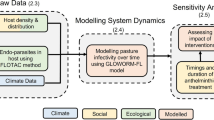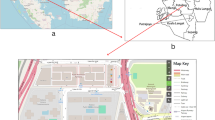Abstract
In the summer of 2006, a bluetongue epidemic started in the border area of Belgium, The Netherlands, and Germany, spread within 2 years over large areas of Western and Central Europe, and caused substantial losses in farm ruminants. Especially sheep and cattle were severely affected, leading to a case–fatality ratio of nearly 40% in sheep (Conraths et al., Emerg Inf Dis 15(3):433–435, 2009). The German federal ministry of food, agriculture, and consumer protection (BMELV) established a countrywide monitoring on the occurrence of the vectors of this virus, i.e., midges (family Ceratopogonidae) of the genus Culicoides. The monitoring was done on 91 sites, most of which were localized in the 150-km restriction zone that existed in December 2006. A grid consisting of 45 × 45 km2 cells was formed that covered the monitoring area. As a rule, one trap was placed into each grid cell. The monitoring program started at the end of March 2007 and lasted until May 2008. It included the catching of midges by ultraviolet light traps—done each month from days 1 until 8, the selection of midges of the Culicoides obsoletus, Culicoides pulicaris group, and other Culicoides spp., the testing of midges for bluetongue virus (BTV) by polymerase chain reaction (PCR), and the daily registration of weather data at each trap site for the whole monitoring period. The following main results were obtained: (1) Members of the C. obsoletus group were most commonly found in the traps, reaching often 3/4 of the catches. The African and South European vector of BTV—the species Culicoides imicola—was never found. (2) Members of the C. obsoletus group were most frequently found infected with BTV besides a few cases in the C. pulicaris group and other species. (3) Members of the C. obsoletus group were also found in winter. Their numbers were reduced, however, and they were caught mostly close to stables. Therefore, a true midge-free period does not exist during the year in Germany. (4) The amounts of midges caught daily depended on the weather conditions. If it was cold and/or windy, the traps contained only a few specimens. Since the months from January to May 2008 were considerably colder (at all farms) than their correspondents in 2007, the growing of the population of midges started 2–3 months later in 2008 than in 2007. (5) The highest populations of midges occurred in both years (2007 and 2008) during the months September and October. This corresponded significantly to the finding of highest numbers of infected midges and to the number of diseased cattle and sheep during these 2 months. (6) It is noteworthy that in general, the first virus-positive midges of the species C. obsoletus were found about 1 1/2 months later than the first clinical cases had occurred or later than the first PCR-proven virus-positive sentinel animals had been documented. In 2007, the first BTV-positive cattle were detected in May in North Rhine-Westphalia, while the first positive Culicoides specimens were only found in August on the same farm. Evaluating these main results of the entomological monitoring and the fact that many wild ruminants have also been infected with BTV, it becomes evident that bluetongue disease has become endemic in Central Europe, and that only constant effort including vaccination and perhaps also insecticidal protection of cattle and sheep will keep the economical losses at a reasonable level. The following papers (1–10) in this journal will contribute more details obtained from this worldwide unique entomological monitoring: Bartsch et al. 2009; Bauer et al. 2009; Stephan et al. 2009; Clausen et al. 2009; Hörbrand and Geier 2009; Kiehl et al. 2009; Mehlhorn et al. 2009; Kiel et al. 2009; Vorsprach et al. 2009; Balczun et al. 2009.


Similar content being viewed by others
References
Anonymous (1876) New disease. Report of the South African cattle and sheep disease commission. Report 16:189–194
Balczun C, Vorsprach B, Meiser CK, Schaub GA (2009) Changes of the abundance of Culicoides obsoletus and C. scoticus in Southwest Germany by PCR differentatiation. Parasitol Res (in press)
Bartsch P., Bauer B, Wiemann A, Clausen PC, Steuber S (2009) Feeding patterns of biting midges of the C. obsoletus and C. pulicaris groups on selected farms in Brandenburg, Germany. Parasitol Res (in press)
Bauer B, Jandowsky A, Schein E, Mehlitz D, Clausen PH (2009) An appraisal of current and new techniques intended to protect bulls against Culicoides species and other haematophagons. Parasitol Res (in press)
Clausen PH, Stephan A, Bartsch S, Jandowsky A, Hoffmann-Köhler P, Schein E, Mehlitz D, Bauer B (2009) Seasonal dynamics of biting midges on dairy farms of Central Germany during the 2007/2008 epidemic of bluetongue. Parasitol Res (in press)
Conraths FJ, Kramer M, Freuling C, Hoffmann B, Staubach C, Gethmann J, Teifke J, Mettenleiter TC, Beer M (2007) Bluetongue disease in Germany: clinical aspects, diagnosis and epidemiology. Der praktische Tierarzt 88:9–15
Conraths FJ, Gethmann J, Staubach J, Mettenleiter TC, Beer M, Hoffmann B (2009) Epidemiology of bluetongue virus serotype 8, Germany. Emerg Inf Dis 15(3):433–435
Darpel KE, Batten CA, Veronesi E, Shaw AE, Anthony S, Bachanek-Bankowska K, Kgosana L, bin-Tarif A, Carpenter S, Müller-Doblies UU, Takamatsu HH, Mellor PS, Mertens PP, Oura CA (2007) Clinical signs and pathology shown by British sheep and cattle infected with bluetongue virus serotype 8 derived from the 2006 outbreak in Northern Europe. Vet Rec 161:253–261
Dobbelaere D, Mckeever D (eds) (2002) Theileria. Kluwer Academic Press, Dordrecht
Hörbrand T, Geier M (2009) Monitoring of Culicoides at 9 locations in Southern Germany. Parasitol Res (in press)
Hoffmann B, Saßerath M, Thalheim S, Bunzenthal C, Strebelow G, Beer M (2008) Bluetongue virus serotype 8. Reemergence in Germany 2007 and 2008. Emerg Infect Dis 14:1421–1423
Hoffmann B, Mehlhorn H, Beer M and The Monitoring Team (2009) Large scale monitoring of putative vectors of BTV-8. Emerg Infect Dis (in press)
Hutcheon D (1881) Fever of epizootic catarrh. Rep Coll Vet Surg 1880:12–15
Hutcheon D (1902) Malarial catarrh fever of sheep. Vet Rec 14:629–633
Kiehl A, Walldorf V, Klimpel S, D’Haese J, Mehlhorn H (2009) Pilot study on the ITS-1, ITS-2 and 18 ss in Germany mitochondrial DNA in Culicoides species that are vectors of bluetongue-disease. Parasitol Res (in press)
Kiel E, Liebisch G, Focke R, Liebisch A (2009) Monitoring of Culicoides at 20 locations in northwest Germany. Parasitol Res (in press)
Loeffler F, Frosch G (1897) Cited in: Wiener E, Ribbeck R (eds) (1978) Wörterbuch der Veterinärmedizin. G Fischer, Jena
Mehlhorn H, Schein E, Ahmed JS (1992) Theileria. In: Kreier JP (ed) Parasitic Protozoans, vol 7, 2nd edn. Academic, San Diego, pp 217–304
Mehlhorn H, Walldorf V, Klimpel S, Jahn B, Jaeger F, Eschweiler J, Hofmann B, Beer M (2007) First occurrence of Culicoides obsoletus-transmitted bluetongue virus epidemic in Central Europe. Parasitol Res 101:219–228
Mehlhorn H, Schmahl G, Schumacher B, D’Haese J, Walldorf V, Klimpel S (2008a) Effects of Bayofly ™ on specimens of Culicoides species when incubated in hair taken from the feet of previously treated cattle and sheep. Parasitol Res 102:519–522
Mehlhorn H, Schmahl G, Walldorf V, D’Haese J, Schumacher B (2008b) Butox® pour-on: a deltamethrin treatment of sheep and cattle: pilot study of killing effects on Culicoides species (Ceratopogonidae). Parasitol Res 102:515–518
Mehlhorn H, Walldorf V, Klimpel S, Schmahl G, Schumacher B, Jatzlau A (2008c) Effects of Flypor®—a permethrin containing pour-on product on Culicoides species after contact with treated hair of cattle and sheep. Parasitol Res (in press)
Mehlhorn H, Walldorf V, Klimpel S, Schmahl G (2008d) Outbreak of bluetongue disease (BTD) in Germany and the danger for Europe. Parasitol Res 103(Suppl):79–86
Mehlhorn H, Walldorf V, Klimpel S, Schmahl G, Al-Quraishy A, Walldorf U, Mehlhorn B, Bätza HJ (2009) Entomological survey on vectors of Bluetongue virus in North Rhine-Westphalia (Germany during 2007–2008). Parasitol Res (in press)
Meiswinkel R, van Rijn P, Leijs P, Goffredo M (2007) Potential new Culicoides vector in Northern Europe. Vet Rec 161:564–565
Saegerman C, Berkvens D, Mellor PS (2008) Bluetongue epidemiology in the European Union. Emerg Infect Dis 14:539–544
Schmahl G, Walldorf V, Klimpel S, Al-Quraishy A, Mehlhorn H (2008) Efficacy of Oxyfly® on Culicoides species—the vector of bluetongue virus—and other insects. Parasitol Res 103(5):1101–1103
Stephan A, Clausen PH, Bauer B, Steuber S (2009) PCR identification of Culicoides dewulfi midges (Diptera: Ceratopogonidae), potential vectors of bluetongue in Germany. Parasitol Res (in press)
Toussaint JF, Sailleau C, Mast J et al (2007) Bluetongue in Belgium 2006. Emerg Infect Dis 13:614–616
Vorsprach B, Meiser CK, Werner D, Balczun C, Schaub GA (2009) Monitoring of Ceratopogonidae in Southwest Germany. Parasitol Res (in press)
Wilson A, Mellor P (2008) Bluetongue in Europe: vectors, epidemiology and climate change. Parasitol Res 103(Suppl):S69–S78
Author information
Authors and Affiliations
Corresponding author
Rights and permissions
About this article
Cite this article
Mehlhorn, H., Walldorf, V., Klimpel, S. et al. Bluetongue disease in Germany (2007–2008): monitoring of entomological aspects. Parasitol Res 105, 313–319 (2009). https://doi.org/10.1007/s00436-009-1416-y
Received:
Accepted:
Published:
Issue Date:
DOI: https://doi.org/10.1007/s00436-009-1416-y




